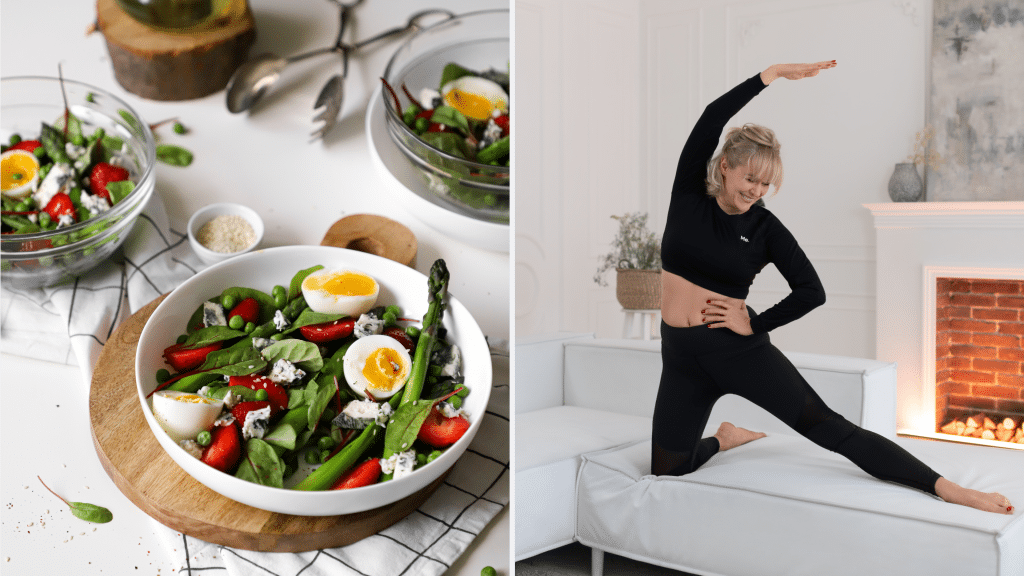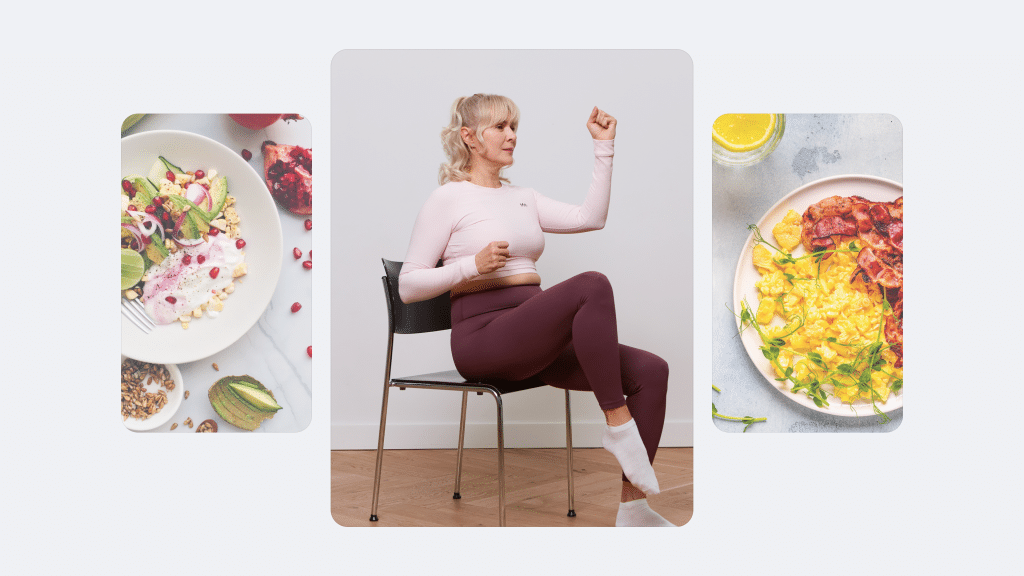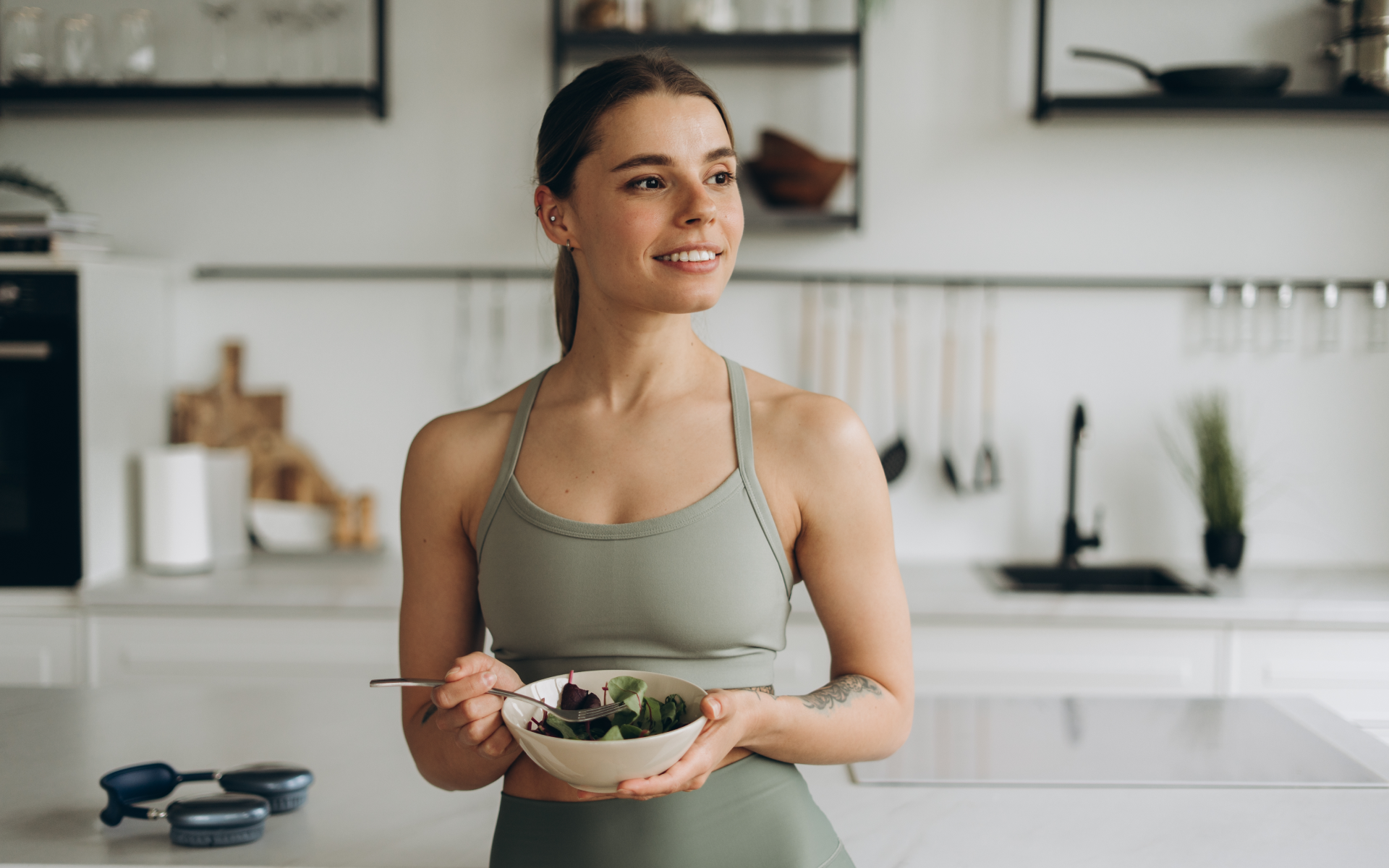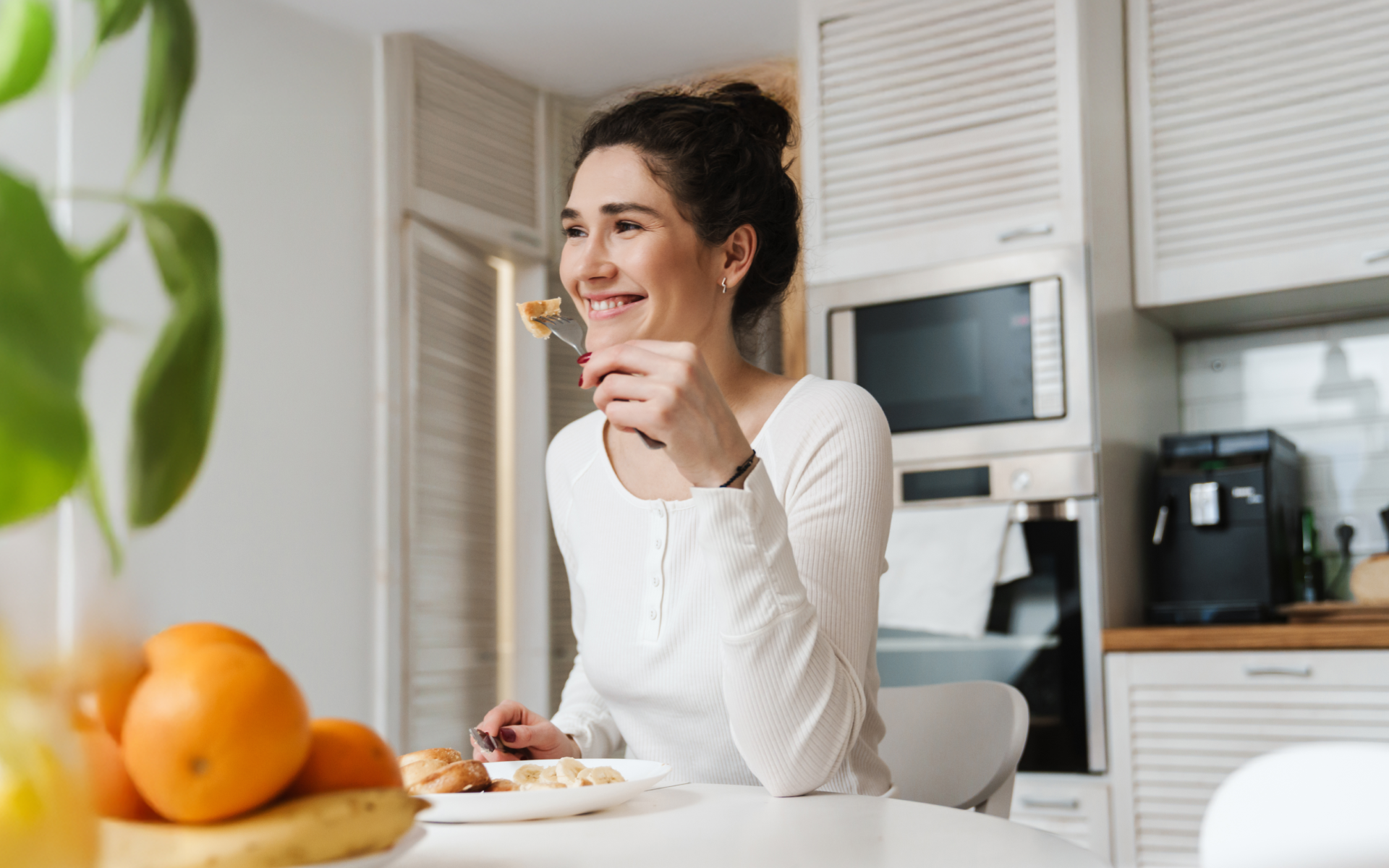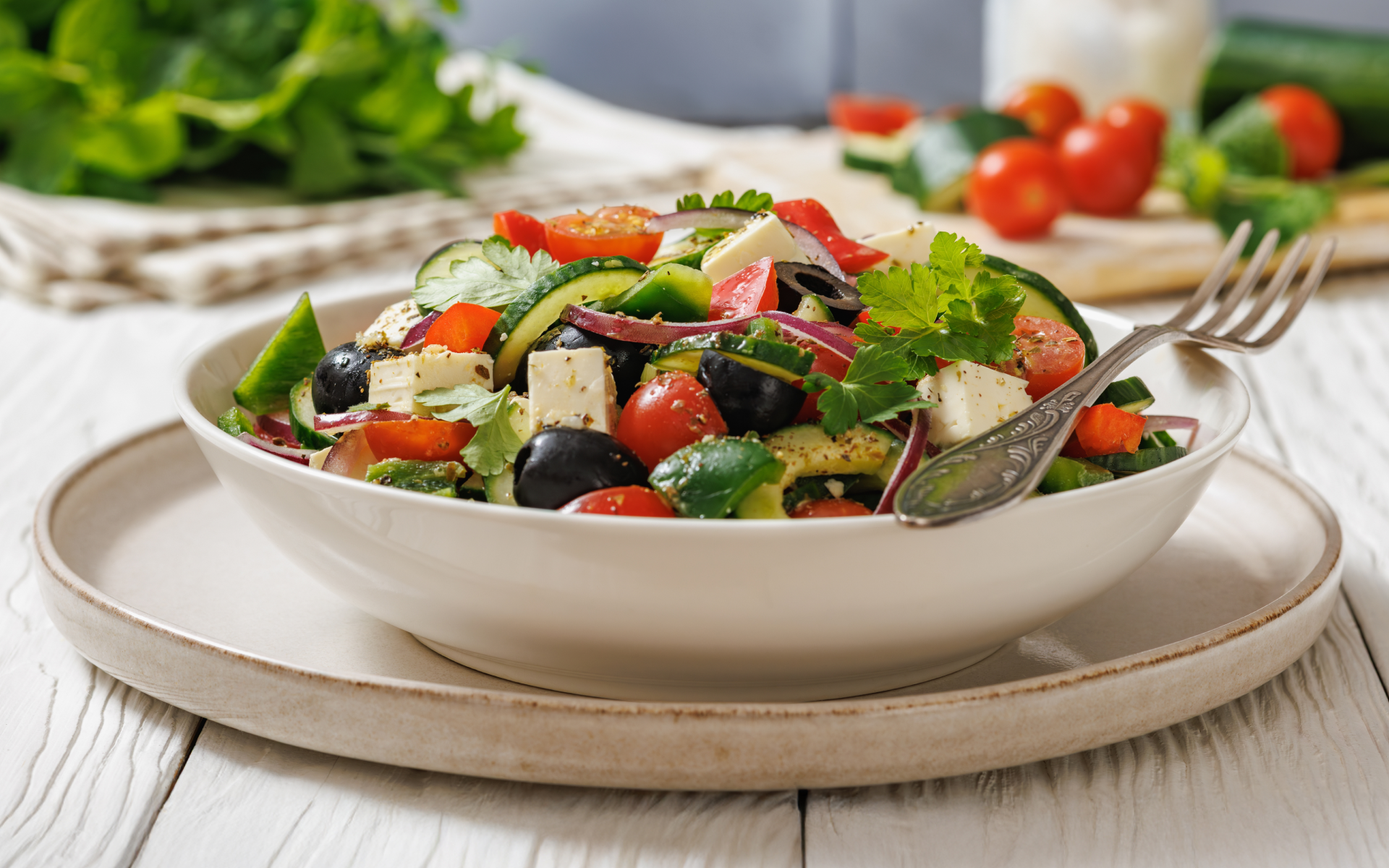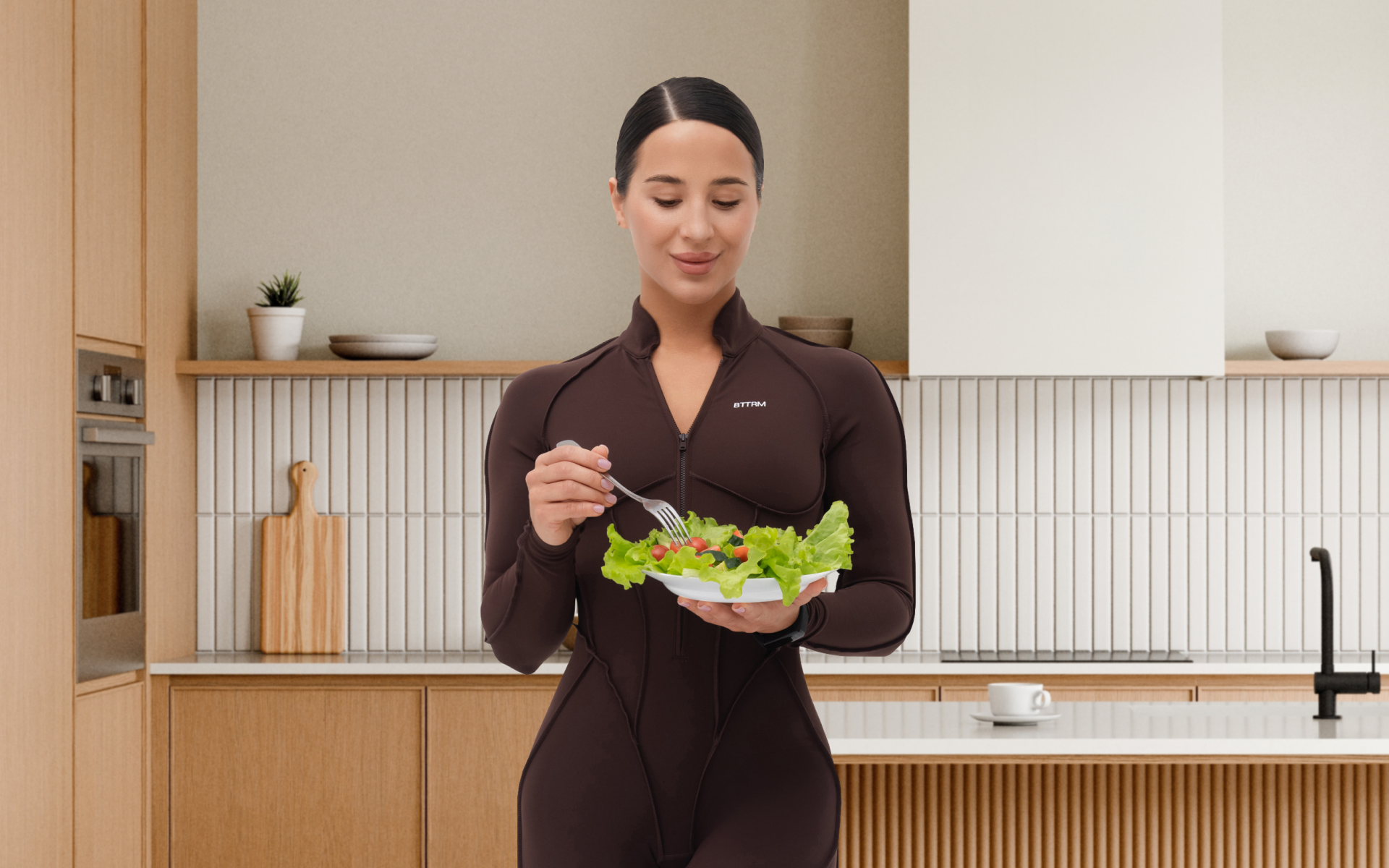Making intentional changes to your diet can help you achieve your weight loss goals while supporting your overall health.
The nutritional needs of women over 50 are evolving and a well-balanced meal plan is one of the most effective ways to address them. This stage of life calls for foods that promote weight loss and nourish your body in meaningful ways, boosting bone health, preserving muscle strength, and supporting hormonal balance (1).
By thoughtfully selecting nutrient-dense, satisfying foods, you can create a sustainable approach to eating that fuels your energy, keeps your cravings in check, and helps you feel your best.
This sample meal plan is designed with these priorities in mind.
What Should a 50-Year-Old Woman Eat to Lose Weight?
A balanced plate that consists of lean protein, complex carbs, healthy fats, and plenty of vegetables is the key to achieving weight loss while meeting your body’s unique nutritional demands after 50.
Lean Proteins
- Chicken
- Turkey
- Fish and seafood (salmon, tuna)
- Eggs
- Tofu and other soy products
- Pulses such as beans, lentils, and chickpeas
Fruits
- Berries (strawberries, blueberries)
- Oranges
- Apples
- Grapefruit
- Pears
Vegetables
- Spinach
- Kale
- Broccoli
- Cauliflower
- Zucchini
- Bell peppers
Whole Grains
- Quinoa
- Brown rice
- Oats
- Whole-grain bread and pasta
- Barley
Healthy Fats
- Avocados
- Nuts and seeds
- Olive oil
- Canola and other vegetable oils
- Fatty fish
Dairy or Alternatives
- Low-fat yogurt
- Skim milk
- Cottage cheese
- Fortified almond milk, soy milk, or other milk alternatives
Beverages
- Water
- Green tea
- Herbal teas
- Black coffee
Read more: Keto Diet Plan For Women Over 50: Everything You Need To Know For Effective Weight Management
What Is a Healthy Sample Meal Plan for a 50-Year-Old Woman to Lose Weight?
For women in their 50s, the estimated daily maintenance calorie range typically falls between 1,800 and 2,200 calories, depending on their activity level. Those who engage in more physical activity may fall closer to the higher end of this range, while less active women will need fewer calories to maintain their weight (2). Other factors, such as body size, also influence overall energy needs.
To lose weight safely and sustainably, it’s recommended to create a calorie deficit of 500 to 750 calories per day. This range generally supports a weight loss of 1 to 1.5 pounds per week, which is backed by research as a healthy rate of loss (3).
That means a woman with a maintenance need of 2,000 calories may aim for 1,250 to 1,500 calories per day. For most people, 1,250 calories is quite low and may be difficult to maintain, so it may make sense to aim closer to 1,500. To determine personalized calorie needs, tools such as online calorie calculators or professional guidance from a registered dietitian are highly useful.
When it comes to weight loss, progress is made by inches, not miles, so it’s much harder to track and a lot easier to give up. The BetterMe: Health Coaching app is your personal trainer, nutritionist, and support system all in one. Start using our app to stay on track and hold yourself accountable!
3-Day Sample Meal Plan for a 50-Year-Old Woman (1,500 Calories Daily)
Below is a three-day sample meal plan totaling approximately 1,400–1,500 calories per day.
Macronutrient Goals
Each day will target roughly:
- Protein (20–25%): 75–94 grams. Supports muscle mass and promotes satiety (4).
- Fat (25–30%): 42–50 grams. Essential for hormonal balance and nutrient absorption (5).
- Carbs (45–50%): 170–188 grams. Provide fuel (6) and dietary fiber for digestion and heart health (7).
Care has been taken to include nutrient-dense, high-fiber, and satisfying foods to address the specific needs of women in this age group.
Day 1
Breakfast
- ½ cup oatmeal (cooked in water)
- 1 tbsp peanut butter
- 1 medium banana (sliced)
- 1 boiled egg
Calories: 340 | Protein: 13g | Carbs: 39g | Fat: 13g
Morning Snack
- ¼ cup almonds
- 1 small apple
Calories: 260 | Protein: 7g | Carbs: 21g | Fat: 19g
Lunch
- 3 oz grilled chicken breast
- 2 cups mixed greens
- ¼ cup shredded carrots
- 5 cherry tomatoes
- 1 tbsp olive oil and vinegar dressing
- 1 medium whole-grain pita bread
Calories: 390 | Protein: 30g | Carbs: 29g | Fat: 15g
Afternoon Snack
- 1 cup plain Greek yogurt (non-fat)
- ⅔ cup mixed berries
Calories: 120 | Protein: 14g | Carbs: 17g | Fat: 0g
Dinner
- 4 oz baked salmon
- 1 cup roasted asparagus (with 1 tsp olive oil)
- 1 medium sweet potato (baked, plain)
Calories: 470 | Protein: 34g | Carbs: 41g | Fat: 17g
Total for Day 1
Calories: 1,580 | Protein: 98g | Carbs: 182g | Fat: 55g
Day 2
Breakfast
- 1 slice whole-grain toast
- ½ avocado, mashed
- 1 scrambled egg (cooked with non-stick spray)
- ½ cup blueberries
Calories: 310 | Protein: 11g | Carbs: 28g | Fat: 17g
Morning Snack
- 1 light string cheese
- 1 small pear
Calories: 150 | Protein: 6g | Carbs: 18g | Fat: 4g
Lunch
- 3 oz grilled turkey breast
- ¾ cup cooked brown rice
- 1 cup steamed broccoli
- 1 tsp olive oil
Calories: 390 | Protein: 33g | Carbs: 36g | Fat: 12g
Afternoon Snack
- 1 boiled egg
- 1 medium orange
Calories: 110 | Protein: 7g | Carbs: 16g | Fat: 4g
Dinner
- 4 oz grilled cod
- 1 cup sautéed spinach (with 1 tsp olive oil)
- 1 small baked potato (plain)
Calories: 460 | Protein: 34g | Carbs: 40g | Fat: 14g
Total for Day 2
Calories: 1,520 | Protein: 91g | Carbs: 178g | Fat: 51g
Day 3
Breakfast
- ½ cup low-fat cottage cheese
- ½ cup mixed berries
- 1 tbsp chia seeds
- 1 slice whole-grain toast
Calories: 240 | Protein: 17g | Carbs: 24g | Fat: 5g
Morning Snack
- ¼ cup walnuts (approximately 7 halves)
- 1 medium apple
Calories: 230 | Protein: 5g | Carbs: 27g | Fat: 17g
Lunch
- 1½ cups lentil soup (low-sodium)
- 1 slice whole-grain bread
- 2 cups mixed greens with balsamic vinegar dressing
Calories: 350 | Protein: 23g | Carbs: 47g | Fat: 6g
Afternoon Snack
- ½ cup plain Greek yogurt (non-fat)
- ¾ cup diced pineapple
Calories: 100 | Protein: 11g | Carbs: 17g | Fat: 0g
Dinner
- 3 oz roasted chicken breast
- 1 cup roasted Brussels sprouts (with 1 tsp olive oil)
- ¾ cup cooked quinoa
Calories: 470 | Protein: 34g | Carbs: 39g | Fat: 14g
Total for Day 3
Calories: 1,520 | Protein: 90g | Carbs: 182g | Fat: 42g
How Can I Lose Weight at 50 and in the Menopause?
The menopause brings hormonal changes, particularly a drop in estrogen, which can affect weight regulation. This shift often leads to fat being stored more in the abdominal area (8). In addition, aging reduces muscle mass, which slows metabolism, making weight loss more challenging (9). However, weight loss during menopause is achievable with the right approach.
- Prioritize Lean Protein
Protein is essential for preserving muscle mass and keeping your metabolism active, particularly during menopause when muscle loss can accelerate. Focus on including high-quality protein sources in every meal, such as eggs, poultry, fish, tofu, and legumes. These foods also help you feel fuller for longer, which reduces the likelihood of overeating. You should aim for 20-30 grams of protein per meal to meet your daily needs effectively (10).
- Strength Train Regularly
Resistance training is one of the best ways to counter muscle loss and maintain a higher metabolic rate as you age (11). Strength-training exercises, such as weightlifting, bodyweight exercises, or resistance band workouts, should be included at least twice a week. These exercises preserve muscle and improve bone density, which is particularly important during and after menopause to prevent osteoporosis (12).
- Focus on Portion Control
As your metabolic needs decrease with age, managing portion sizes becomes more important to avoid unwanted weight gain (13). Opt for smaller plates to naturally reduce portion sizes, and measure calorie-dense ingredients such as cooking oils, dressings, and nuts.
Prioritize nutrient-dense foods like vegetables, whole grains, and lean proteins over ultra-processed, high-calorie options to ensure you get the nutrients you need without excess calories (14).
Reasons why BetterMe is a safe bet: a wide range of calorie-blasting workouts, finger-licking recipes, 24/7 support, challenges that’ll keep you on your best game, and that just scratches the surface! Start using our app and watch the magic happen.
- Manage Stress and Sleep
Menopause often brings challenges such as disrupted sleep and heightened stress, both of which can lead to increased cortisol levels and potential fat gain, particularly around the midsection (15). To manage stress, you should consider incorporating mindfulness practices such as meditation, yoga, or deep breathing exercises into your routine.
For better sleep, establish a consistent bedtime, avoid screens before bed, and create a calming nighttime environment. Quality sleep and stress management are essential for your overall health and can make it easier to maintain a healthy weight (16, 17).
- Stay Active Throughout the Day
Regular physical activity supports a healthy metabolism, improves cardiovascular health, and helps with weight management (18, 19). Activities such as walking, cycling, swimming, or gardening can keep you active and burn extra calories throughout the day.
Beyond traditional workouts, look for opportunities to stay on your feet, such as taking the stairs, stretching during breaks, or going for short walks after meals. Staying active in your daily life is just as important as structured exercise for maintaining overall health.
Read more: How Much Weight Can A 50-Year-Old Woman Lose In A Month?
What’s the Fastest Way for a 50-Year-Old Woman to Lose Weight?
Fast Doesn’t Mean Healthy or Sustainable
For women over 50, sustainable weight loss is more important than rapid results. Dramatic calorie cutting or extreme dieting can result in nutrient deficiencies and muscle loss. Instead, you should aim for steady progress while maintaining lean body mass.
Adopt Evidence-Based Practices
- Create a Calorie Deficit
Use an online calculator to determine your maintenance calories, then aim for 500–750 fewer calories daily to support gradual, safe weight loss. Ensure this doesn’t drop below 1,200–1,500 calories for women, as extremely low-calorie diets can slow your metabolism (20).
- Choose Nutrient-Dense Foods
High-fiber vegetables, lean proteins, and healthy fats keep you full longer, which reduces the likelihood of overeating (21). Avoid empty-calorie foods such as sugary snacks or sodas.
- Combine Diet with Exercise
Pairing strength training with cardiovascular activities promotes fat burning and muscle maintenance (12, 22). The fastest path is consistent action, not shortcuts.
While adjustments may lead to quick initial losses (often due to water weight), long-term focus ensures lasting results without compromising health.
What Are the Essential Steps to Kick Start Weight Loss After 50?
- Step 1: Set Realistic Goals
Establish clear, achievable weight loss goals. Aiming for 1–2 pounds per week is realistic and supports sustainable habits.
- Step 2: Assess Your Current Diet
Track what you eat for a week to understand calorie intake and identify habits (e.g. mindless snacking). Apps or food journals can help you get started.
- Step 3: Prioritize Protein and Fiber
Protein maintains muscle and keeps hunger at bay (4), while fiber improves digestion and promotes satiety (7). Include foods such as fish, chicken, lentils, oats, and leafy greens in your meals. Our previous post goes into great detail about the protein and fiber foods.
- Step 4: Increase Physical Activity
If you’re new to exercise, start small by walking regularly or taking gentle fitness classes. Gradually add strength-training exercises to support your metabolism.
- Step 5: Hydrate and Sleep Well
Drinking water improves metabolism and prevents hunger from being mistaken for thirst (23). Getting 7–9 hours of sleep helps with hormonal balance and reduces cravings (24).
- Step 6: Seek Support
Enlist accountability – whether through a dietitian, personal trainer, or a friend. Support makes it easier to stay committed.
How Long Should a 50-Year-Old Woman Fast to Lose Weight?
Intermittent fasting (IF) can be helpful for creating the calorie deficit that is required to burn fat (25). However, hormonal changes during this stage of life increase sensitivity to overly restrictive diets, potentially causing undue stress. Fasting isn’t necessary for weight loss, but it can work as a tool if it’s implemented thoughtfully.
- Choose a Gentle Fasting Approach
A 12- to 14-hour fasting window (e.g. overnight fasting) is often sufficient and less stressful. For example, you stop eating at 7 p.m. and resume at 9 a.m. You can work your way up to a longer fasting window, such as 16:8 (fasting for 16 hours and eating within an 8-hour window), but you should always listen to your body and adjust accordingly.
- Combine Fasting with Balanced Eating
Fasting alone doesn’t guarantee results. Follow the calorie deficit and macronutrient guidelines appropriate for weight loss and include nutrient-dense foods in your eating window. This strategy is best combined with balanced, informed meal choices.
- Consider Your Energy Levels
Longer fasting windows (16-18 hours) may not be ideal if you experience fatigue, energy crashes during exercise, or heightened stress. Listen to your body and adjust accordingly.
- Hydrate Wisely
During fasting periods, focus on hydrating with water, herbal teas, or black coffee. Avoid sugary drinks or added sugars or creamers (26, 27) as they can disrupt the fasting process.
- Consult a Healthcare Professional
Fasting isn’t suitable for everyone, particularly those with specific medical conditions (28), so consult a healthcare professional before you start.
The 3-3-3 diet is a meal planning concept where individuals eat three meals a day, each consisting of three balanced macronutrients – protein, fats, and carbs – and follow it consistently for three weeks. While it emphasizes balanced eating, it’s important to customize any diet to individual needs and ensure the total calorie intake is aligned with your weight goals. Yes, a woman over 50 can reduce belly fat through a combination of strategies. These include creating a moderate calorie deficit, eating a balanced diet rich in lean proteins, healthy fats, and whole grains, and engaging in regular exercise – including strength training and cardiovascular activities. Managing stress and improving sleep is also essential, as both of these can influence fat storage, particularly around the abdomen (29, 30). Lemon water doesn’t typically break a fast, as it contains minimal calories (less than 1 calorie in a squeeze of lemon juice). Drinking plain lemon water can help you stay hydrated during fasting periods without disrupting the fasting state. However, adding sugar or other ingredients will break the fast. Yes, sleep counts as part of a fasting period. For example, if you fast for 12 hours overnight and sleep for 8 of those hours, that time is included in your fasting window. This is why methods such as intermittent fasting often incorporate overnight fasting to make it easier to achieve fasting periods.Frequently Asked Questions
What is the 3-3-3 diet?
Can a woman over 50 lose belly fat?
Does lemon water break a fast?
Does sleep count as fasting?
The Bottom Line
Losing weight at 50 is totally achievable if you have the right approach. A balanced, nutrient-dense meal plan that creates a manageable calorie deficit of approximately 500 calories per day is a proven way to promote weight loss while meeting your body’s changing nutritional needs. Incorporating ample lean protein, fiber-rich foods, healthy fats, and whole grains is essential for supporting your muscle health, metabolic function, and overall well-being. The sample meal plan and steps provided can help you get started, but you should always listen to your body and adjust as needed.
DISCLAIMER:
This article is intended for general informational purposes only and does not serve to address individual circumstances. It is not a substitute for professional advice or help and should not be relied on for making any kind of decision-making. Any action taken as a direct or indirect result of the information in this article is entirely at your own risk and is your sole responsibility.
BetterMe, its content staff, and its medical advisors accept no responsibility for inaccuracies, errors, misstatements, inconsistencies, or omissions and specifically disclaim any liability, loss or risk, personal, professional or otherwise, which may be incurred as a consequence, directly or indirectly, of the use and/or application of any content.
You should always seek the advice of your physician or other qualified health provider with any questions you may have regarding a medical condition or your specific situation. Never disregard professional medical advice or delay seeking it because of BetterMe content. If you suspect or think you may have a medical emergency, call your doctor.
SOURCES:
- The Importance of Nutrition in Menopause and Perimenopause—A Review (2023, ncbi.nlm.nih.gov)
- How Much Should I Eat? Quantity and Quality (2022, nia.nih.gov)
- Healthy Eating Plan (n.d., nhlbi.nih.gov)
- The role of protein in weight loss and maintenance (2015, sciencedirect.com)
- Biochemistry, Lipids (2023, ncbi.nlm.nih.gov)
- Physiology, Carbohydrates (2023, ncbi.nlm.nih.gov)
- The Health Benefits of Dietary Fibre (2020, ncbi.nlm.nih.gov)
- Estrogen Deficiency and the Origin of Obesity during Menopause (2014, ncbi.nlm.nih.gov)
- Metabolic changes in aging humans: current evidence and therapeutic strategies (2022, ncbi.nlm.nih.gov)
- Dietary Protein and Muscle Mass: Translating Science to Application and Health Benefit (2019, ncbi.nlm.nih.gov)
- How can strength training build healthier bodies as we age? (2022, nia.nih.gov)
- Strength training: Get stronger, leaner, healthier (2023, mayoclinic.org)
- What is the role of portion control in weight management? (2014, ncbi.nlm.nih.gov)
- Nutrition (2023, health.harvard.edu)
- Menopause—Biology, consequences, supportive care, and therapeutic options (2023, sciencedirect.com)
- Sleep is essential to health: an American Academy of Sleep Medicine position statement (2021, jcsm.aasm.org)
- Stress Management (2023, ncbi.nlm.nih.gov)
- Benefits of Physical Activity (2024., cdc.gov)
- Health Benefits of Exercise (2018, ncbi.nlm.nih.gov)
- Optimal Diet Strategies for Weight Loss and Weight Loss Maintenance (2020, ncbi.nlm.nih.gov)
- Optimising foods for satiety (2015, sciencedirect.com)
- The (Many) Benefits of a Cardio Workout (2023, health.clevelandclinic.org)
- Increased Hydration Can Be Associated with Weight Loss (2016, ncbi.nlm.nih.gov)
- Role of Sleep and Sleep Loss in Hormonal Release and Metabolism (2010, ncbi.nlm.nih.gov)
- Intermittent fasting and weight loss: Systematic review (2020, ncbi.nlm.nih.gov)
- About Water and Healthier Drinks (2024, cdc.gov)
- Rethink Your Drink (2023, cdc.gov)
- To Fast or Not to Fast (2019, newsinhealth.nih.gov)
- Sleep Deprivation: Effects on Weight Loss and Weight Loss Maintenance (2022, ncbi.nlm.nih.gov)
- Obesity and Stress: A Contingent Paralysis (2022, ncbi.nlm.nih.gov)

